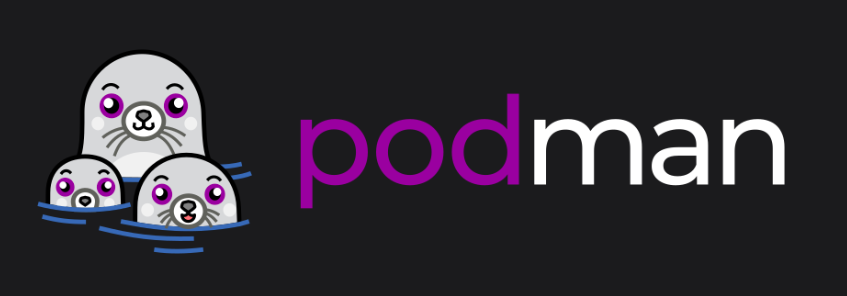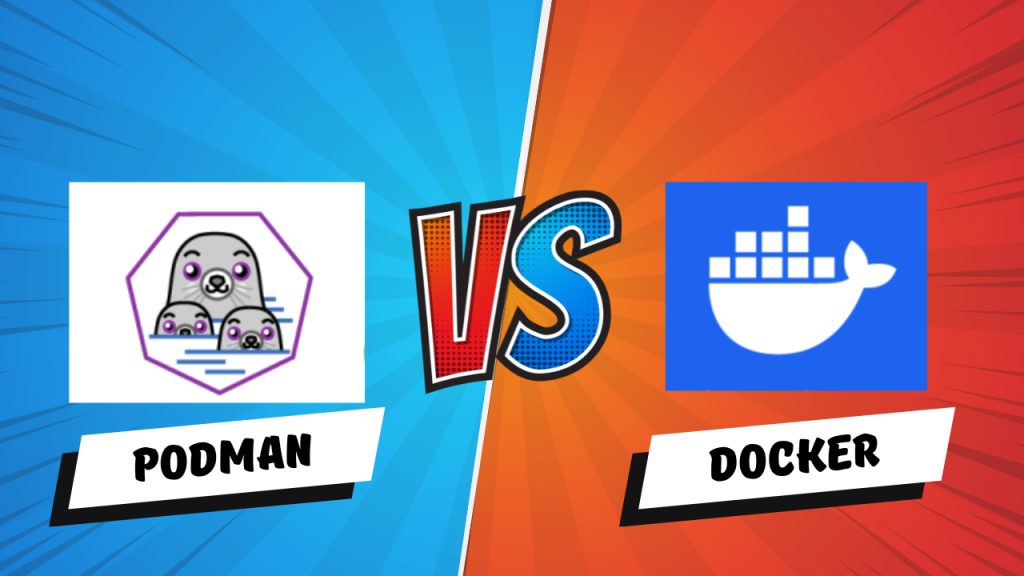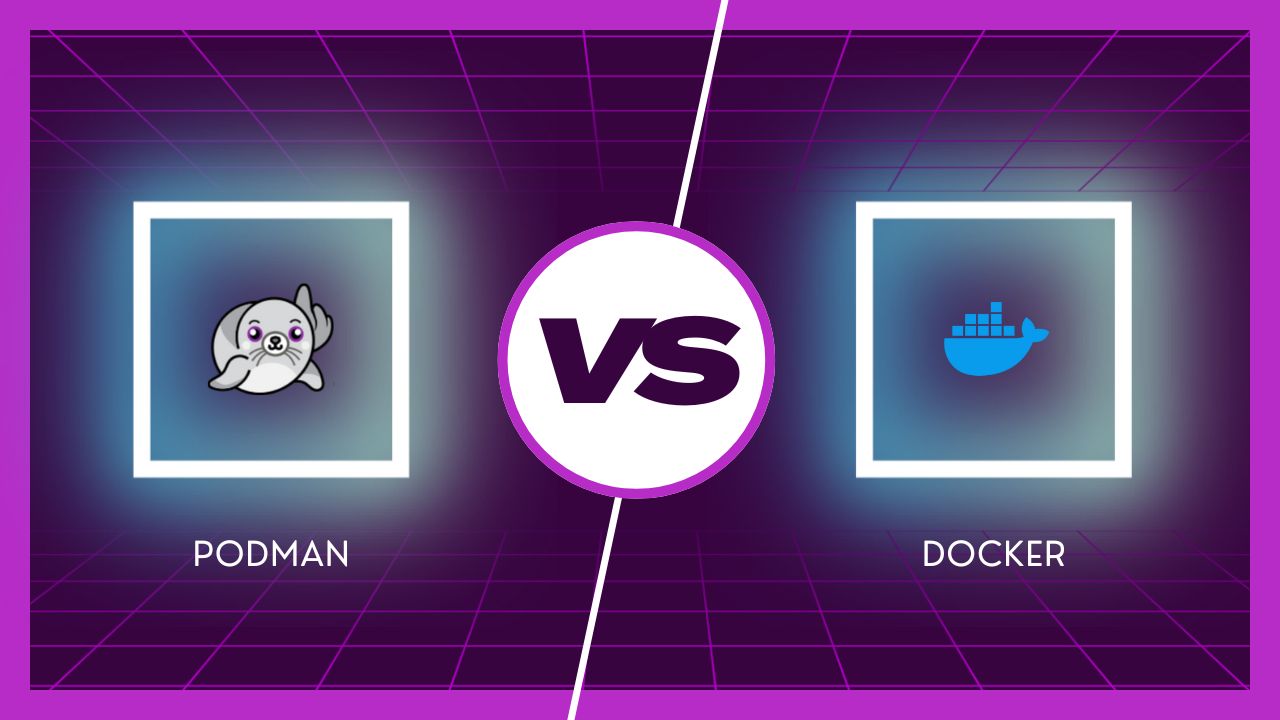Podman vs Docker is an ongoing debate!
If you’ve worked with containers, you’ve undoubtedly heard the disagreements, but what distinguishes these two tools? And why is that important to you?
Many of you are aware of Docker, the popular option that has completely changed how we deploy apps. With the brave promise, “We can do what Docker does—only better, safer, and without needing a daemon!” Podman, a new competitor and an orchestration tool, has just entered the game.
Both containerization tools Docker vs Podman are known to streamline development, deployment, and container management. However, they differ in several important areas that affect usability, security, and performance.
Developers ask, Which is better for scalability? Which provides greater security? Above all, which tool will rule the containerization landscape in the future?
To get your answer Stay tuned as we’re going to dig deep into the world of Podman vs Docker in this article compare key differences, and help you decide on the better containerization tool for your next project in 2024!
Get exclusive access to all things tech-savvy, and be the first to receive
the latest updates directly in your inbox.
The Need To Understand Containerization
A technology used by developers to package an application, containers, which are separated, lightweight units that hold various components including binaries, configuration data, and libraries.
Regardless of where it’s deployed on a cloud server, your laptop, or a friend’s PC, this tool ensures consistent application across the board matter where you launch it.
Containers are completely separated from one another, sharing the host operating system’s kernel, in comparison with typical virtual machines (VMs), which virtualize a full operating system. This leads to less overhead, quicker startup times, and more effective resource use.
Podman vs Docker: A Simple Overview Before Moving Forward
Let’s first try to understand each containerization tool individually before we compare Podman vs. Docker.
What is Podman?

In a newly formed container market with many more participants, Introduced in 2018 Podman is a rising star.
Podman is a Red Hat project and an open-source and free tool for creating, controlling, and executing containers and container images.
The OCI Containers definition is compatible with that. Although it can be installed on many distributions, Podman is a component of RedHat Linux.
For Linux users, Podman (Pod Manager) is a daemonless container engine that facilitates the creation, administration, and execution of Open Container Initiative (OCI) containers. Containers can operate in rootless or root mode.
What is Docker?

You’ve likely heard the other well-known name Docker from the world of containers. a platform built in 2015 that allows apps to be built and set up, your web servers, applications, and databases, automatically inside portable, lightweight containers separately.
Although it wasn’t the first container engine, Docker has come to represent containerization in many ways. Many people use “Docker” as a shorthand for containers because many of Docker’s functionality is the de facto standard for container-based development.
Using a client-server architecture, container management communicates between the Docker client and the Docker daemon. It performs the tedious task of assembling, maintaining, and distributing Docker vs Podman containers.

What is a daemon? (A daemon is a service or background process that operates automatically and doesn’t require user input).
Podman vs Docker: Key Differences
Both Podman vs Docker are quite similar in many ways but one has been a constantly preferred choice for years, let’s find out why.

1. Podman vs Docker: Architecture Comparison

Let’s begin by comparing Docker’s daemon vs Podman’s daemon-less mode. One of the key differences between Podman vs. Docker is how they manage containers.
Docker Has a Daemon Based Architecture

Docker vs Podman uses a Docker Daemon an ongoing centralized program that runs in the background and runs a container, such as creating, starting, stopping, and removing containers.
Because the Docker daemon runs with root capabilities, there can be security risks. There could be vulnerabilities throughout the system if the daemon is compromised.
Then to manage containers, Docker uses a client-server architecture, where the Docker client and daemon communicate with one another.
Pros
- Makes container management easier.
- Centralized management of every container.
Con’s
- Performance overhead may arise from the requirement for a daemon to run continuously.
- Security issues because the daemon frequently operates as the root user.
Podman has a Daemon-less Architecture
The main factor that differentiates Podman vs. Docker is that it is daemon-less which means there isn’t an ongoing process for handling your containers in the background. It doesn’t require that!

Without a daemon, it communicates directly with the Linux kernel and container runtime interface. By allowing Podman to operate containers without root capabilities, this design improves security because every container operates independently. It won’t affect the other containers even if the parent is responsible for one container crash.
Also, Podman’s CLI is compatible with Docker, developers familiar with Docker can switch to Podman with little difficulty. Containers in Podman can group to form “pods” that function as a unit.
Pros
- Root privileges are not necessary, lowering security threats.
- Lower resource overhead because there isn’t a daemon operating all the time.
- Perfect for settings requiring rootless containers or stringent security rules.
Cons
- needs a little more manual involvement than the centralized daemon of Docker.
2. Podman vs Docker: Security Compared

Let’s find out which is the safer option. By operating the container with non-root rights, Podman and Docker both adopted the rootless mode, increasing security.
Docker
Keep in mind how a daemon performs a large portion of Docker’s continuous work. Its fundamental need puts it in danger even though it incorporates multiple security features into its design.
Naturally, a weakness in the Docker daemon exposes the entire system; as root access is required, the system as a whole may be hacked. Because of its strong security features and best practices, Docker vs Podman is widely used despite these concerns.
Podman
Because each container in Podman using the fork-exec model, operates in its private user namespace and is isolated from the others, the probability of an attack that targets the entire system is significantly less.
On top of that, given Podman’s design, it minimizes potential attack surfaces, and it is one of the best options for deployments where security is significant.
3. Podman vs Desktop: Ease of Use
Docker
A broad range of CLI commands is made available by Docker to facilitate the creation, administration, and deployment of applications within containers.
Podman
With no changes needed, Podman vs. Docker functions straight out of the box and utilizes the same CLI command.
4. Podman vs Docker: Performance Compared
Docker
Performance is one area where Docker appears to have an advantage over Podman, at least in some cases. Docker uses more resources, even when no containers are active or running in the background.
It has historically had a quick startup time because of its effective well-integrated tools like image layering, and caching systems.
CPU Utilization in Docker: Because Docker containers require the Docker daemon, they may have slightly higher CPU consumption.
Podman
Podman offers better performance especially if we consider its efficient resource usage, its daemonless architecture, which eliminates any need for daemon communication, results in quicker container startup times. Podman might provide a little advantage for large-scale installations or instances where starting time is crucial.
CPU Utilization in Podman: typically more effective CPU consumption when they don’t have a persistent daemon running.
5. Podman vs Docker: Compatibility
Both containerization tools are OCI- Compliant, Let’s see how Docker vs Podman differ in compatibility and integration.
Podman vs. Docker can be used in situations that are compatible because of the open standards and OCI compliance. You can start a container in Docker or Podman and make changes to it using either tool. Kubernetes can also be used with these containers.
Because developers are used to using Docker, the Podman command line interface is based on it. By directing Docker commands to Podman, Podman makes the transition from Docker to Podman smooth.
Here’s an example of a clear compatibility difference in how Docker vs Podman handles Docker compose:
Docker Compose
A tool that creates and manages multi-container Docker apps using this file,
docker-compose.ymlwhich lets programmers build intricate environments with just one command. Like the following:
docker-compose upPodman
Being CLI compliant with Docker, podman doesn’t support Docker Compose. Installing an additional tool such as postman-compose is required to use Docker Compose with Podman. Nevertheless, compared to Docker’s native support, postman-compose might occasionally experience compatibility problems with more complicated settings or specific Docker-compose capabilities, making it less smooth.
6. Podman vs Docker: Image Building
The image-building process differs in Podman vs. Docker containerization tools.
Docker
It is very self-sufficient when it comes to building images, as it uses a centralized daemon that builds, manages, and stores them.

Docker Build command is used with the daemon which converts a dockerfile to an image.
Podman
On the other hand, This containerization tool needs Buildah to build images. It doesn’t require a Dockerfile, the podman build command works similarly to Docker’s. Buildah provides more flexibility, in the creation and manipulation of images. This gives you more control over the process of creating an image, but it could also need more effort on your part.

Podman works directly with image registries without the need for a daemon, which may speed up the entire process.
7. Podman vs Docker: Managing Services Compared
Docker
Multi-container application management is handled by Docker Compose, while orchestration to run a cluster of Docker nodes is handled by Docker Swarm. It allows the dependability-free deployment of scaled applications.
Although each of these tools greatly increases the power of container management, there are additional components to understand and maintain.
Podman
With Podman’s integration with Systemd, containers are managed similarly to typical system services. For users who are already familiar with systemd, this integration makes container orchestration on systems that use it easier.
Use Cases for Podman vs Docker
Here are some practical use cases for Podman vs Docker to help you choose the right tool for your project.
When to Choose Docker
- CI/CD Pipelines: Because Docker works smoothly with CI/CD systems like Jenkins, GitLab CI, or Travis CI, it’s an excellent choice for containerizing applications throughout the build, test, and deployment process.
- For Large-scale Productions: perfect for managing cloud-based microservices architectures with the help of Docker Swarm & Compose on AWS, Google Cloud, or Azure.
- Projects run on different platforms: such as MacOS, Windows, and Linux ensure Docker guarantees consistency and consistent execution in various contexts.
Ideal scenarios For Podman
- Workloads for Kubernetes: Suitable for executing Kubernetes workloads, enabling the creation and administration of containers without additional overhead.
- Systemd Services: Because it offers superior process management, it is recommended to manage containers.
- Testing and Development: Docker-compatible CLI streamlines development processes.
- Stronger Security Environments: Perfect for daemon-less and rootless container operations to reduce security threats.
Key Takeaways: Can Podman Replace Docker Anytime Soon
In summary, Podman vs Docker is an ongoing debate among developers, both containerization tools are powerful and offer amazing benefits depending on your project’s specific needs and requirements.
Docker is preferred for its mature ecosystem, seamless integration in Cloud environments, CI/CD pipelines, and large-scale applications that can benefit greatly from its smooth multi-container management and ease of use.
On the other hand, Podman is also gaining more popularity, When it comes to handling many containers, Podman offers superior support compared to Docker. With the Pod model, managing a stack of services is simple. Its daemonless, rootless functionality and Docker compatibility make it a desirable choice for developers in need of safe, lightweight solutions.
Docker takes the win here as it was introduced in 2015, so it can be said that there’s still a long way to go for Podman to match Docker’s popularity.
But it all comes down to size, security, and the resources of your project. It’s important to monitor both Docker vs Podman tools to see how they develop going forward as containerization continues to change.
FAQs: Podman vs Docker
What distinguishes Podman vs Docker from one another?
Podman lacks a daemon, whereas Docker makes use of a central daemon. This is the main distinction. Docker needs root rights to operate, while Podman can run containers without them, providing greater security.
What benefits does Podman offer in terms of security?
By allowing rootless container execution, which runs containers without elevated rights, Podman reduces security vulnerabilities. This is especially helpful in settings with multiple users.
How are images handled by Docker vs Podman?
Docker vs Podman can both pull, build, and manage container images. On the other hand, Podman handles images without a central daemon and saves images differently.
Can I convert Podman to Docker containers?
Yes, as long as they follow the OCI guidelines, you can utilize the same container images in Podman as you did in Docker.
What common uses does Podman have?
CI/CD pipelines, production microservices, and resource-efficient development environments are among the cases where Podman is perfect.



